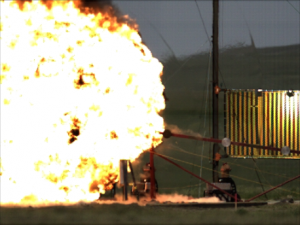Military
When the Department of Defense realized that soldiers riding inside its new Mine-Resistant Ambush-Protected vehicles were still being injured by improvised explosive devices, it turned to the UVa Center for Applied Biomechanics for answers. Among other questions, the Pentagon wanted to know why the injuries were occurring, what could be done to prevent them and why they went unnoticed during initial testing.
A team of CAB researchers led by principal scientist Rob Salzar has begun answering these questions. "These are not the kinds of intrusion injuries you see in a typical accident," he says. "Because of the thickness of the armor, the floor might move just half an inch, but it’s been driven by 500 to 1,000 Gs of force. This causes complex injuries at the point of contact, the foot and ankle as well as the pelvis." CAB designed an underbody blast simulator to develop injury criteria for these explosions and is conducting biofidelity tests to support fast track development of a new crash test dummy for blasts. Next, CAB will focus on mitigating the blast effects to minimize injuries. "Our strengths are our understanding of the battery condition to humans in a variety of different environments and our ability to develop rigs that replicate them," Salzar says.
The main goal of the CAB is to increase soldier survivability and performance. Our research runs the gamut from blunt trauma to ballistics and blast. Our unique skills allow us to examine and prevent injuries from the cellular level, through to the body armor and helmet level, all the way to the occupant level.
Projects and Areas of Research

Army
- Investigate the injury and response of vehicle occupants subjected to under-body blast. The work conducted will be used to create injury criteria for use in the development of injury mitigation strategies.
- Current anthropometric test devices (ATDs) have limited applicability to monitoring human response in a under-body blast environment and the development of appropriate countermeasures. For this reason, a comprehensive integrated research plan was developed to maximize currently available information and to coordinate the collection of appropriate tests that will be the basis for the design of Warrior Injury Assessment Manikin.
- Characterize the high rate material property changes of the brain due to acute blunt trauma.
Navy
- Advances in propulsion technology have created the necessity to increase the acceleration pulse associated with aircraft seat ejections to the highest levels tolerable in order to ensure that the aviator is ejected in time. The increased ejection rates have resulted in numerous spinal injuries from an ejection loading that is directed vertically along the spine. The Center for Applied Biomechanics has been tasked with characterizing the kinematics of an ejection seat occupant.(ONR-NAVAIR)
- High rate material characterization of through thickness skull bone for material response.
Air Force
- High g/shock head sensor development for improved monitoring of air craft occupants to TBI exposure
Sponsors and Collaborators
- Army Research Lab (ARL)
- Duke University
- United States Army Aeromedical Laboratory (USAARL)
- United States Department of Defense-Army Medical Research Acquisition Activity (AMRAA)
- Johns Hopkins Applied Physics Lab (APL)
- Office of Naval Research (ONR)
- United States Navy Naval Air Systems Command (NAVAIR)
- United States Department of Defense-Medical Research and Materiel Command (MRMC)
- Air Force Research Lab (AFRL)